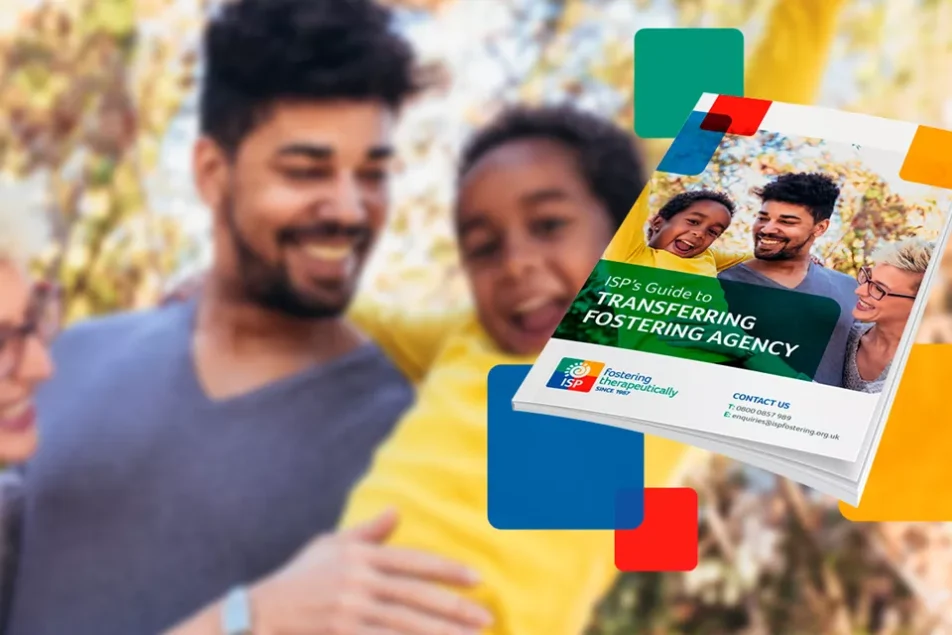
How to heal from trauma
Discover the strategies and therapeutic perspectives you need to help young people in care recover from emotional trauma and lead healthy, happy lives.
Healing from trauma is a difficult and potentially lifelong challenge many young people in care face, and living with the symptoms of trauma can be traumatising in itself.
If left unsupported, trauma can manifest in all areas of a young person’s life, affecting their chances of a bright and fulfilling future. However, with the right support and therapeutic perspectives, recovery from trauma is possible.
In this article, you’ll learn:
How our brains develop
Our brains develop from the bottom up. It starts with the lower and mid-level regions that control basic functions like breathing and fight-or-flight responses.
It then develops higher parts of the brain that are responsible for more executive functions like empathy and emotional regulation.
How trauma impacts brain development
Repeated frightening experiences – such as abuse or neglect – over a prolonged period of time, can have a significant impact on the way in which a child’s brain develops and how they function day-to-day.
At ISP, we use the following analogy to help our foster parents understand the impact of developmental trauma…
Imagine a child’s brain is a house
- Downstairs – lower and mid-regions develop first and are responsible for basic emotions, flight-or-fight responses and strategies for survival.
- Upstairs – develops later and enables empathy, future planning, cause-and-effect thinking and reflective practice.
- Staircase – allows the child to access and integrate all parts of the brain. However, they need a safe relationship with a trustworthy adult at key stages in their development to help them build it.
In the case of a child living with developmental trauma, this staircase is likely to be extremely shaky. They will have spent much of their time living in their ‘downstairs brain’ surviving.
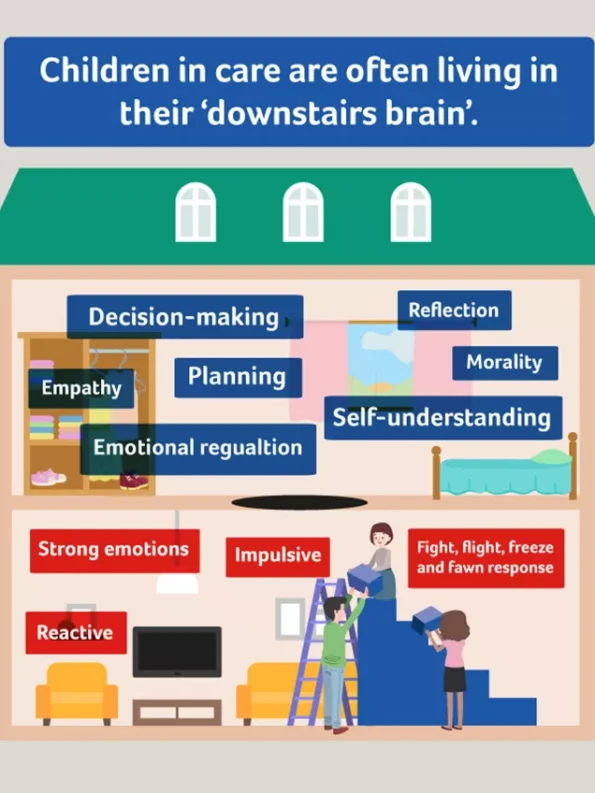
Healing from trauma takes time
In the case of the house analogy, our job as foster parents is to help fortify that staircase and show them the ways in which the ‘upstairs’ and ‘downstairs’ can work together.
When all parts of the brain can work as a team, we are best placed to live a happy and fulfilled life. However, it’s important to remember that it takes time and persistence.
If you try to rush it, just imagine instead of a staircase there’s a big hole, and each time the child is taken ‘upstairs’, they fall back down and crash back into survival mode where fight, flight and fawn survival responses take control.
That’s why the effects of trauma on behaviour can be so prevalent when young people join a new foster family. They’re suddenly thrust into a new environment which can feel jarring and alien to them. The unknown feels unsafe to them, leading them to stay downstairs in survival mode.
This is one reason why being patient and slowly establishing trust is crucial in helping to bridge the gap and help our young people regain control over their lives.
How to heal from childhood trauma in 3 stages
As we’ve discussed, the brain develops in a certain order, and so when we’re working with young people in care whose early experiences have resulted in trauma, we deal with parts of the brain in the same order and build from the ground up.
Here are the 3 stages of recovery from trauma for young people and what foster parents need to do to help them…
1) Safety and stabilisation
We start off by doing things that help the young person to:
- Feel safe in their body
- Feel safe in their physical environment
- Help them to emotionally regulate
We do this by helping to ground them with things that are repetitive or rhythmic, form part of a routine, engage all the five senses and are supported within the context of a safe and nurturing relationship.
This gives them an anchor point to hold onto while they try a different way of navigating those difficult feelings and sensations.
It can be helpful to think about this stage as working on the brainstem, which is the first part of the brain to develop as a baby.
2) Coming to terms with experiences that have led to trauma
When the young person can cope with the distressing experiences and the symptoms of trauma are a little better, the next stage is to work with the limbic system. This is the place where sensations, emotions and reactions are experienced.
Our young people in care are likely to have big feelings, so they need to be able to cope with the distress that their memories and feelings bring up.
Here it’s about processing their trauma and really exploring the impact of that. This helps them to access the top part of the brain again, so they’re able to assess what happened, what they’ve learnt and who they are as a person.
Through therapy and other healing tools, young people can gain insights, process their emotions, and gradually integrate their traumatic experiences into their overall life story.
3) Integration and moving on
The final stage focuses on rebuilding their life and reconnecting with themself and others in a meaningful way. It involves:
- Developing healthier coping strategies
- Rebuilding relationships
- Rediscovering personal identity and purpose
This stage is often centred around self-care, self-compassion, and cultivating a supportive network of relationships.
It’s important to note that healing from complex trauma is an ongoing journey, and people may continue to work on healing and growth throughout their lives.
Strategies for healing trauma in children
There are various perspectives that foster parents can adopt to help children who are recovering from trauma.
1) See the child as a toddler or baby
Children with trauma are often stuck at the very early developmental stage, which means they’re in ‘baby mode’. This is likely because their needs were not met at that crucial stage of development.
So when your young person is expressing themselves in a way that’s not conducive to the environment, imagine them as a toddler or baby. Toddlers and babies cry, scream or shout to communicate, and the same might be going on here.
The cost of surviving is often not having developed age-appropriate skills to communicate effectively due to their psychological trauma.
2) Connect before you correct
It’s important to understand the reasons behind a young person’s behaviour before we start to make interventions to try to help them change.
- What are the emotions?
- What are the feelings driving their behaviour?
A really useful way to slow down our tendency to react to a child’s behaviour is to put yourself in their shoes and understand how it helped them stay safe in their early life.
Until we can demonstrate that we understand and accept these behaviours, and can show over a long period of time that they’re no longer needed, it’s going to be almost impossible for the child in your care to move forward.
Through this process, you will be providing the child in your care with a new experience; one where they can begin to trust an adult who understands and accepts them. Someone who they can rely on to support them to recover.
3) Create a predictable schedule
Routines, schedules and agreements are crucial in building a safe environment. Simple things like having a predictable routine will help your child feel confident about shared expectations and what’s happening next.
When we think about the chaotic and unpredictable experiences many of our children have endured it’s easy to see how this is an important part of healing.
4) Practice PACE
To help develop more secure relationships for young people living with trauma, we can parent with PACE – play, acceptance, curiosity and empathy.
These are the key building blocks to establishing trust and allowing your young person to feel confident within themselves and the people around them.
Your young person might find this challenging at first and may struggle to accept the authenticity of your connection. But just remember many children in care will have had lots of experiences where connections with adults weren’t safe.
Self-protective strategies like rejecting your love and attention, and staying distant to avoid hurt and disappointment later, make perfect sense in the context of a child who has experienced this before. Children living with complex trauma won’t give these strategies up quickly or easily.
The key is to be consistent in your care and build trust through your day-to-day interactions. It can take some time, but PACE combined with love and meeting their needs can help children who are healing from attachment trauma and see them begin to form positive, healthy relationships.
6) Social and relationship difficulties
Trauma can significantly impact a child’s ability to form and maintain healthy relationships. Many children in care will have learned through their past experiences that connections are not safe or consistent.
Some may isolate themselves to avoid future disappointment, while others may need to be around you constantly to feel safe.
A different parenting approach is needed for children with trauma
When caring for a child who is healing from childhood trauma, it’s important that you put aside your own ideas or memories about what parenting looks like. Plus, the typical strategies given to parents which are designed for children who haven’t had trauma at a young age.
These strategies and techniques – including ‘time out’ or confiscating toys as punishment – don’t work for children healing from trauma because they often lack the capacity to understand consequences. The upstairs brain responsible for cause-and-effect thinking may not have had the chance to develop.
So, when you punish a child living with trauma in these ways, they may respond as if you think they are inherently bad and that they are losing your love.
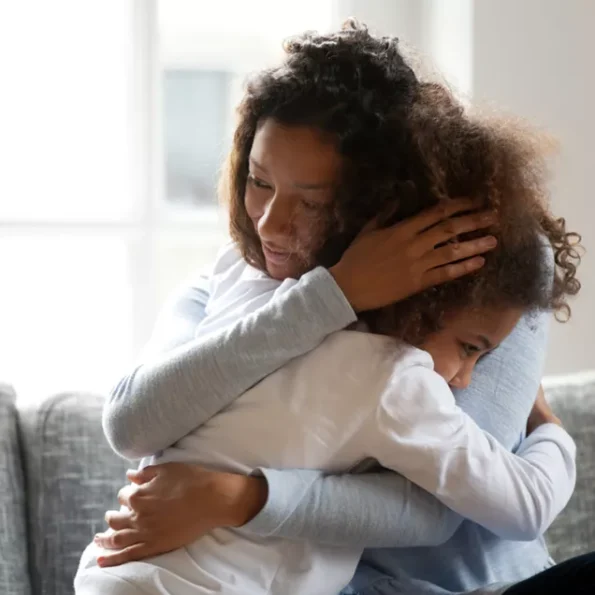
Learn about trauma…
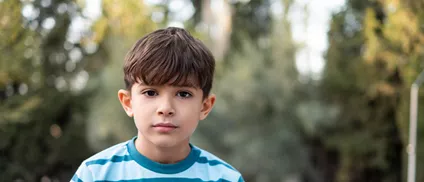
The impact of trauma
Discover the impact of early childhood trauma, and what it means for young people in foster care.

Trauma and the brain
Learn about the profound impact that childhood trauma can have on brain development.
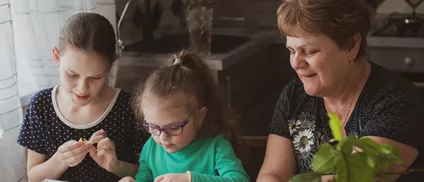
PACE parenting
Learn how to use the PACE approach in daily interactions to build a connection and diffuse difficult situations.
